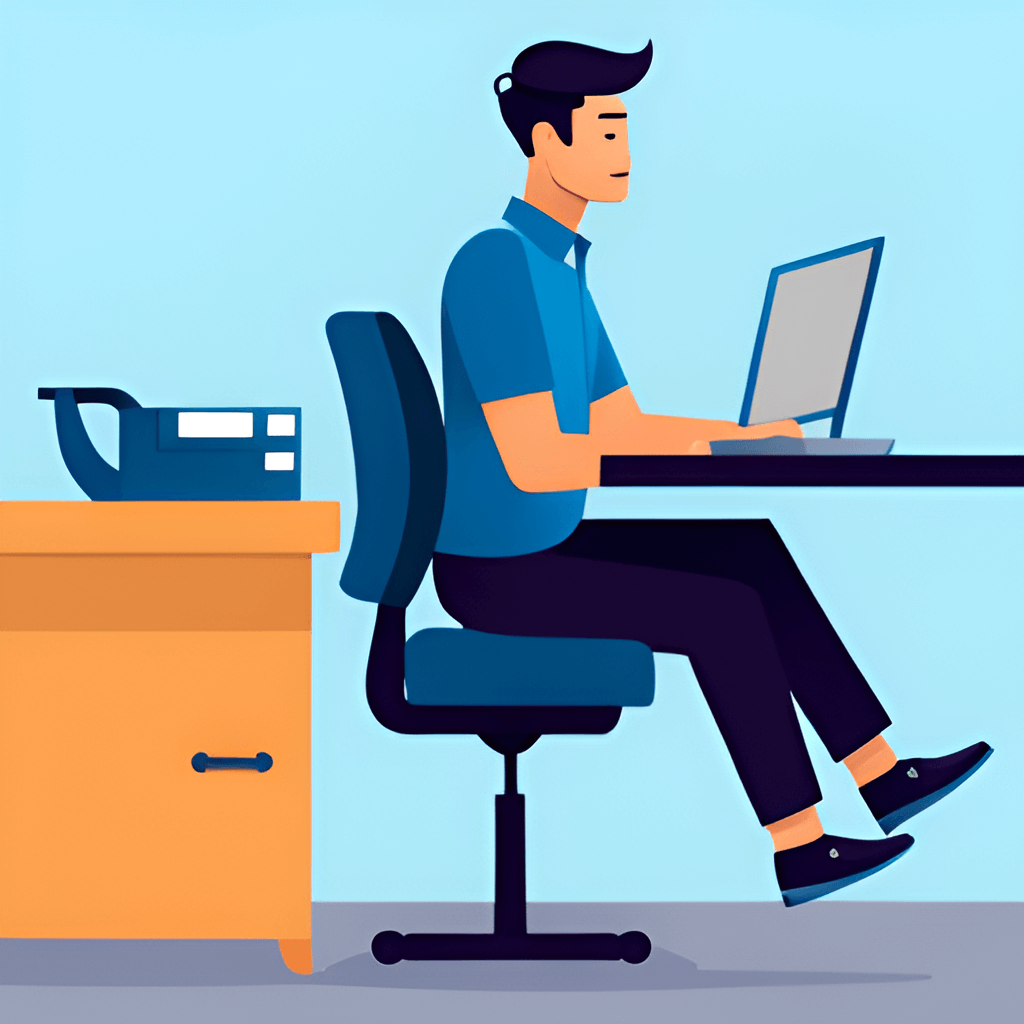
Stay Active at Work: Exercises to Counteract Prolonged Sitting
| Exercise | Benefits | Duration |
|---|---|---|
| Seated Leg Raises | – Improved circulation and leg muscle engagement | 5-10 minutes |
| Desk Push-Ups | – Upper body workout for chest, shoulders, and triceps | 5-10 minutes |
| Chair Squats | – Strengthening leg muscles and preventing stiffness | 5-10 minutes |
| Neck Stretches | – Alleviating tension and reducing neck pain | 3-5 minutes |
| Seated Torso Twists | – Improved spinal mobility and reduced lower back strain | 5-10 minutes |
Please note that the mentioned durations are approximate and can vary depending on your fitness level and how many repetitions you perform. It’s important to listen to your body and take short breaks throughout the day to incorporate these exercises and maintain your overall health and productivity.
Introduction
Welcome to Opvital, your trusted source for work and life-related advice. In today’s fast-paced world, we often find ourselves tethered to our desks for hours on end, caught in the endless cycle of work tasks. But what if we told you that staying active at work could not only improve your health but also enhance your productivity? If you’re looking to boost your overall well-being and get more done during the workday, this article is for you.
The Impact of Prolonged Sitting on Health and Productivity
We’ve all been there – sitting for hours, eyes fixed on the screen, and barely moving a muscle. While it may seem like you’re being productive, the reality is that prolonged sitting can have dire consequences for your health and efficiency.
Health Implications of Sitting for Extended Periods
Sitting for prolonged periods has been linked to a slew of health issues, including:
- Obesity: A sedentary lifestyle can lead to weight gain and obesity, increasing the risk of various health conditions. Read more about the link between prolonged sitting and obesity.
- Cardiovascular Issues: Reduced blood circulation and increased pressure on the heart are common consequences of sitting too long.
- Posture-Related Problems: Slouching or poor sitting posture can result in back and neck pain, leading to discomfort and reduced mobility. Learn how to maintain a good posture while sitting on an office chair.
The Toll on Productivity
Beyond its impact on health, prolonged sitting can wreak havoc on your productivity:
- Energy Drain: Remaining seated for long stretches can drain your energy, leaving you feeling lethargic.
- Decreased Focus: Mental fatigue can set in, reducing your ability to concentrate on tasks.
- Lower Efficiency: With reduced energy and focus, your efficiency and output suffer.
Why Incorporating Exercises at Work Matters
To combat these negative effects and unlock your full potential, incorporating exercise into your work routine is crucial.
Boosting Energy and Focus
Exercise is a proven method to increase energy levels and enhance focus. When you engage in physical activity, your body releases endorphins, those feel-good hormones that provide an instant energy boost. This newfound energy can help you tackle tasks with renewed vigor and concentration.



Improving Overall Well-Being
Beyond the immediate benefits of energy and focus, regular exercise at work can lead to long-term improvements in your well-being. It can reduce stress, boost your mood, and even enhance your creativity—all of which contribute to increased productivity.
Desk-Friendly Exercises
Now, let’s get to the heart of the matter: desk-friendly exercises that can easily become part of your daily work routine. These exercises are designed to counteract the negative effects of prolonged sitting without requiring a gym membership or extensive equipment.
Discover more exercises to counteract prolonged sitting.
Exercise 1: Seated Leg Raises
- Sit upright in your chair with your feet flat on the ground.
- While keeping your back straight, lift one leg until it’s parallel to the ground.
- Hold for a few seconds, then lower it.
- Repeat with the other leg.
- Aim for 10-15 raises per leg.
This exercise helps improve circulation and engages your leg muscles, combating the sedentary effects of sitting.
Exercise 2: Desk Push-Ups
- Stand facing your desk, about arm’s length away.
- Place your hands on the edge of the desk, shoulder-width apart.
- Lean forward and lower your chest toward the desk, then push back up.
- Perform 10-15 repetitions.
Desk push-ups work your chest, shoulders, and triceps, providing a quick upper-body workout.
Exercise 3: Chair Squats
- Stand in front of your chair with your feet hip-width apart.
- Lower yourself into a seated position on the chair, then stand back up.
- Repeat 10-15 times.
Chair squats are excellent for strengthening your leg muscles and preventing stiffness.
Exercise 4: Neck Stretches
- Sit up straight in your chair.
- Slowly tilt your head to the left, bringing your left ear toward your left shoulder.
- Hold for 15-30 seconds, then repeat on the right side.
- Perform 2-3 sets on each side.
Neck stretches alleviate tension and reduce the risk of neck pain associated with prolonged sitting.
Exercise 5: Seated Torso Twists
- Sit with your feet flat on the ground and your back straight.
- Hold the armrests of your chair or the sides of your desk.
- Slowly twist your torso to the left, hold for a few seconds, then return to the center.
- Repeat on the right side.
- Perform 10-15 twists on each side.
This exercise helps improve spinal mobility and reduces the strain on your lower back.
Quick Breaks for Optimal Health and Efficiency
Incorporating these desk-friendly exercises into your daily routine is essential, but don’t forget to take short breaks throughout the day.
Sample Schedule for Exercise Breaks
- Morning Break: Start your day with 5 minutes of leg raises and 5 minutes of neck stretches.
- Lunch Break: Dedicate 10 minutes to chair squats and desk push-ups.
- Afternoon Break: Spend 5 minutes on seated torso twists to refresh your body and mind.
By following this schedule, you’ll accumulate essential physical activity without disrupting your work flow.
Ergonomics and Workspace Setup
While exercises are a fantastic way to counteract prolonged sitting, your workspace setup plays a crucial role in supporting these efforts.
The Importance of Ergonomics
An ergonomic workspace minimizes the risk of discomfort and injury associated with prolonged sitting. Ensure that your chair, desk, and computer monitor are appropriately adjusted to promote good posture.
Investing in Ergonomic Accessories
Consider investing in ergonomic accessories like standing desks, balance boards, or adjustable chairs. These tools can further enhance your workspace, making it easier to incorporate movement into your workday.
Explore the different types of standing desks to elevate your work.
Encouraging Workplace Wellness
Lastly, remember that employers can also play a significant role in promoting workplace wellness.
Supportive Employers
Employers who prioritize employee health benefit from a more productive workforce. Encourage your workplace our yourself to:
- Provide standing desks or sit-stand desk converters for employees.
- Organize fitness challenges or wellness programs to promote physical activity.
- Foster a workplace culture that values and supports employee well-being.
Conclusion
In the quest to improve your health and productivity, don’t underestimate the power of staying active at work. By incorporating desk-friendly exercises, taking regular breaks, optimizing your workspace, and advocating for workplace wellness, you can achieve a healthier work-life balance. At Opvital, we’re committed to providing trustworthy information to help you lead a more fulfilling and productive life. Remember, a few minutes of movement each day can make a world of difference in your overall well-being and effectiveness at work. So, why not start today?
FAQs – Staying Active at Work and Desk-Friendly Exercises
Staying active at work is crucial to counteract the negative effects of prolonged sitting. It can improve your physical health, boost energy levels, enhance focus, reduce stress, and ultimately increase productivity.
Yes, desk-friendly exercises are designed to be quick and convenient. You can easily incorporate them into short breaks throughout your workday, ensuring minimal disruption to your schedule.
Most of the exercises mentioned in the article require only a chair and a desk. You don’t need any special equipment or a gym membership to perform these exercises effectively.
It’s recommended to incorporate short exercise breaks during your workday. A suggested schedule is provided in the article, but you can adapt it to your preferences. The key is to move regularly and avoid prolonged periods of sitting.
If you have a specific medical condition or injury, it’s advisable to consult with a healthcare professional or physical therapist before engaging in these exercises.
Additional Resources
- Digital Marketing Tools: The Importance of Marketing Tools
 The Importance of Marketing Tools In today’s digital landscape, businesses …
The Importance of Marketing Tools In today’s digital landscape, businesses …Digital Marketing Tools: The Importance of Marketing Tools Read More »
- A Guide to Fundamental Marketing Tools for Businesses
 What are marketing tools? At Opvital, we’re dedicated to shedding …
What are marketing tools? At Opvital, we’re dedicated to shedding …A Guide to Fundamental Marketing Tools for Businesses Read More »
- The Significance of Marketing Tools
 Key Takeaways for Marketing Tools Marketing Tools Overview – Diverse …
Key Takeaways for Marketing Tools Marketing Tools Overview – Diverse … - A Comprehensive NeuronWriter Review: Unveiling Its SEO Powers
 Welcome to Opvital’s in depth NeuronWriter Review. NeuronWriter is more …
Welcome to Opvital’s in depth NeuronWriter Review. NeuronWriter is more …A Comprehensive NeuronWriter Review: Unveiling Its SEO Powers Read More »
